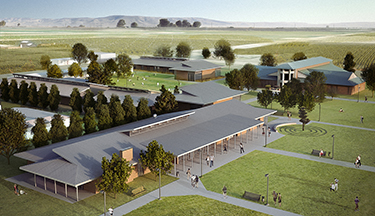|
Subscribe / Renew |
|
|
Contact Us |
|
| ► Subscribe to our Free Weekly Newsletter | |
| home | Welcome, sign in or click here to subscribe. | login |
Construction
| |
 |
November 21, 2019
Creating a sense of place for students in rural Washington
Olson Kundig

O'Toole
|
Since its founding in 1982, Heritage University has ensured equitable access to a student population historically underserved by institutions of higher learning.
A strategic master plan and new campus buildings designed by Olson Kundig ensure the university can continue this important work far into the future.
Heritage University is home to 708 undergraduate and 202 graduate students with an average age of 24. More than two-thirds of Heritage students are Hispanic, including students from migrant and seasonal farmworker families. Most are the first in their families to attend college and almost all students receive financial aid. Evening and online courses further support students who work full-time.
“This is a population that is hungry for education but has been historically denied that opportunity,” said Tom Kundig, principal and owner of Olson Kundig. “These projects presented a humbling opportunity to give back to this community and genuinely impact current and future students.”
Vision for the future
For its campus in rural Toppenish, Yakima County, Heritage University made use of a few existing buildings and began adding temporary modular structures in response to growing student enrollment, but lacked a long-term plan to address future growth. Existing facilities provided basic space for classrooms, administration and student services, but minimal space for gathering and study. Moreover, buildings didn’t relate to each other cohesively or establish a sense of place on campus.
“The university wanted students to feel really welcome and comfortable on campus, but hadn’t been able to strategically foster those kinds of spaces,” said Kundig.
After Petrie Hall, a historic schoolhouse building, burned down in 2012, the university saw an opportunity to thoughtfully plan for the future.
Olson Kundig was hired to develop a new master plan outlining campus development through 2025. Kundig and fellow principal and owner Kirsten Murray worked closely with university administrators and students to develop a plan that would address both aspirational and programmatic components.
The plan integrated new buildings with existing facilities to create a welcoming environment for students, faculty, staff and visitors. A road map for incremental growth over time enables the university to take on future construction projects as funding allows, informed by an over-arching campus vision.
The master plan emphasizes core themes of accessibility, diversity, community engagement and equity. Planned buildings clarify circulation routes, strengthening edges to provide well-defined gathering spaces. Communal buildings, such as the dining commons and student services center, are interspersed with classroom buildings to allow students to mix and interact throughout the day. A comprehensive plan for future landscaping defines a more formal entry to announce arrival on campus and incorporates native plantings to attract local bird populations.
To date, five new Olson Kundig-designed buildings have been constructed with Chervenell Construction Co. on the university campus, with additional phases planned: a new Petrie Hall classroom and arts building; Rick and Myra Gagnier Hall, home to the IT Help Center; the Gaye and Jim Pigott Dining Commons; the Martha B. Yallup Health Sciences Building, which houses the physician assistant program; and the Violet Lumley Rau Administrative Center, home to student services and the university’s largest classroom.
The clean lines and highly structured interior programs of these buildings provide functional spaces for students and staff. Gracious internal proportions and lofted ceilings give classrooms and gathering spaces a feeling of volume, while clerestory windows and skylights capture natural daylight.
“The new Heritage University buildings are essentially civic buildings,” said Kundig. “They’re designed to be places of pride as well as learning, to showcase the students and their work.”
The new buildings create a consistent architectural language for the Heritage University campus, while continuing to break down barriers to access. Gently pitched roofs relate to the local agricultural vernacular. Reclaimed bricks from previous campus buildings, including the original Petrie Hall, are incorporated into the facades of new buildings, connecting Heritage University’s past with its future.
A new relationship between the built environment and campus open space helps to create a dedicated quad for the campus. This deliberate series of both built and open space also defines different areas of campus, while strengthening circulation pathways.
Supporting interaction
Olson Kundig’s design of the new buildings emphasizes mixing and exchange. Large areas of transparency maximize daylight and frame exterior views of the learning taking place within. Entries strategically located at the “gaskets” of buildings, where two program spaces collide, foster interaction among student groups. Intermixed academic and administrative buildings continue to weave together different populations and types of programs throughout campus.
“It was vital to the university that the campus support collaboration and interaction among the entire student body and with faculty and staff,” said Kundig. “We didn’t want to end up with everyone siloed in individual programs, so we’ve designed every building — both current and planned — to support that interaction and cadence of space.”
Iconic architectural moments punctuate and enhance the campus plan, providing focal points that help guide circulation and increase the visibility of the university’s wide-ranging campus activities. A large roll-up door allows the new Petrie Hall art space to both influence and respond to the activity of the surrounding campus. At the dining commons, an exterior loggia creates a front porch for student activity; dedicated gathering space spills between indoor and outdoor areas, providing year-round use even during inclement weather.
Construction is paused for the moment. Olson Kundig remains involved with fundraising and cultivation efforts for future expansion in the meantime.
“This project highlights the power of architecture to unite a community and foster access and equity,” said Kundig. “Those values are fundamental to Olson Kundig’s practice, so we’re incredibly proud to work with Heritage University and excited for the next phase.”
Cate O’Toole is a marketing coordinator at Olson Kundig.
Other Stories:
- Designing classrooms that meet the needs of tomorrow’s jobs
- 3 projects that show how unique context can inspire unique design
- Make your transition to a new building a smooth one
- 3 STEM projects that aim to break down learning silos
- How higher ed projects can benefit from P3 delivery
- Why it’s a good idea to use mechanical design-build for your school project
- New lab building anchors UC San Diego research park
- How maker labs can open doors to STEM careers
- UW building takes fast track with integrated design-build
- Community college complex will be a hub for agriculture



